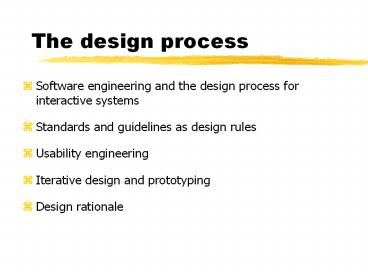The design process - PowerPoint PPT Presentation
Title:
The design process
Description:
The design process Software engineering and the design process for interactive systems Standards and guidelines as design rules Usability engineering – PowerPoint PPT presentation
Number of Views:71
Avg rating:3.0/5.0
Title: The design process
1
The design process
- Software engineering and the design process for
interactive systems - Standards and guidelines as design rules
- Usability engineering
- Iterative design and prototyping
- Design rationale
2
Introduction
Paradigms and principles concentrated on
examining the product of interactive system
design. Now we focus on the process of
design. Software engineering is the emerging
discipline for understanding the design process,
or life cycle. Designing for usability occurs
at all stages of the life cycle, not as a single
isolated activity
3
The software life cycle
The waterfall model
4
Activities in the life cycle
Requirements specification designer and customer
try capture what the system is expected to
provide can be expressed in natural language or
more precise languages, such as a task analysis
would provide Architectural design high-level
description of how the system will provide the
services required factor system into major
components of the system and how they are
interrelated needs to satisfy both functional and
nonfunctional requirements Detailed
design refinement of architectural components and
interrelations to identify modules to be
implemented separately the refinement is governed
by the nonfunctional requirements
5
Verification and validation
Verification designing the product
right Validation designing the right
product The formality gap validation will
always rely to some extent on subjective means of
proof Management and contractual issues design
in commercial and legal contexts
6
The life cycle for interactive systems
cannot assume a linearsequence of activitiesas
in the waterfall model
7
Using design rules
Design rules suggest how to increase
usability Standards set by national or
international bodies to ensure compliance by a
large community of designers standards require
sound underlying theory and slowly changing
technology hardware standards more common than
software high authority and low level of
detail ISO 9241 defines usability as
effectiveness, efficiency and satisfaction with
which users accomplish tasks
8
Using design rules (cont'd)
Guidelines more suggestive and general many
textbooks and reports full of guidelines abstract
guidelines (principles) applicable during early
life cycle activities detailed guidelines (style
guides) applicable during later life cycle
activities understanding justification for
guidelines aids in resolving conflicts
9
Usability engineering
The ultimate test of usability based on
measurement of user experience Usability
engineering demands that specific usability
measures be made explicit as requirements Usabil
ity specification usability
attribute/principle measuring concept
measuring method now level/ worst case/
planned level/ best case Problems usability
specification requires level of detail that may
not be possible early in design satisfying a
usability specification does not necessarily
satisfy usability
10
Iterative design and prototyping
Iterative design overcomes inherent problems of
incomplete requirements Prototypes simulate or
animate some features of intended
system different types of prototypes
throw-away incremental evolutionary Managem
ent issues time planning non-functional
features contracts
11
Techniques for prototyping
Storyboards need not be computer-based can be
animated Limited functionality simulations some
part of system functionality provided by
designers tools like HyperCard are common for
these Wizard of Oz technique Warning about
iterative design design inertia early bad
decisions stay bad diagnosing real usability
problems in prototypes. . and not just the
symptoms
12
Design rationale
Design rationale is information that explains why
a computer system is the way it is. Benefits of
design rationale communication throughout life
cycle reuse of design knowledge across
products enforces design discipline
presents arguments for design trade-offs
organizes potentially large design space
capturing contextual information
13
Design rationale (contd)
Types of DR Process-oriented preserves order
of deliberation and decision-making Structure-or
iented emphasizes post hoc structuring of
considered design alternatives Two examples
Issue-based information system (IBIS) Design
space analysis
14
Issue-based information system (IBIS)
- basis for much of design rationale research
- process-oriented
- hierarchical structure of issues, with one root
issue - positions are potential resolutions of an issue
- arguments modify the relationship between
positions and issues - gIBIS is a graphical version
15
Design space analysis
- structure-oriented
- QOC hierarchical structure
- questions (and sub-questions)
- represent major issues of a design
- options
- provide alternative solutions to the question
- criteria
- the means to assess the options in order to
make a choice - DRL similar to QOC with a larger language and
more formal semantics
16
Psychological design rationale
- to support task-artefact cycle in which user
tasks are affected by the systems they use - aims to make explicit consequences of design for
users - designers identify tasks system will support
- scenarios are suggested to test task
- users are observed on system
- psychological claims of system made explicit
- negative aspects of design can be used to improve
next iteration of design
17
Summary
The software engineering life cycle distinct
activities and the consequences for interactive
system design Using design rules standards and
guidelines to direct design activity Usability
engineering making usability measurements
explicit as requirements Iterative design and
prototyping limited functionality simulations
and animations Design rationale recording
design knowledge process vs. structure































